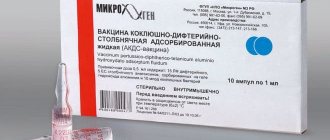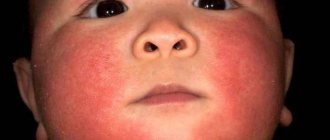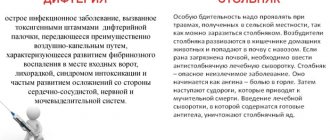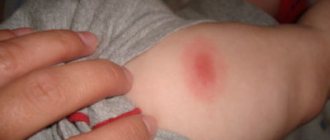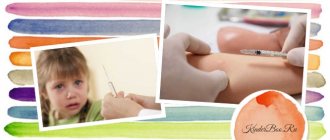Diphtheria
Diphtheria is a bacterial infection characterized by specific changes in the oropharynx and a pronounced toxic syndrome. Diphtheria is transmitted by airborne droplets (from a patient or a carrier during breathing), less often by contact (from contaminated objects). Infection occurs approximately 2-10 days from the moment of contact.
Diphtheria is characterized by pronounced changes in the oropharynx. The throat turns red, then becomes covered with a dense fibrin film, which is difficult to separate from the mucous membranes, and sometimes makes breathing difficult. Diphtheria of the larynx is accompanied by hoarseness and loss of voice, difficulty breathing, and in some cases bleeding.
The diphtheria bacillus is an infectious agent that can produce a toxin. Under its influence, a toxic syndrome develops in the body - swelling of the upper respiratory tract and subcutaneous fat. At the same time, patients feel clearly unwell: high fever, difficulty breathing, headaches. In addition, the disease is often complicated by myocarditis and pathology of the nervous system (encephalitis). To treat diphtheria, antibiotics are used, as well as antitoxic serum or immunoglobulin.
Diphtheria is now rare. It's not very contagious. But this disease is serious, and in the pre-vaccination era it was in first place as the cause of child mortality.
Prevention of diphtheria
Prevention consists not only of vaccination, it also includes other measures. Diagnosis of the disease and identification of carriers of the diphtheria bacillus are important. These persons are subject to hospitalization and treatment. Disinfection plays an important role.
The problem of migration is becoming increasingly relevant, so it is necessary to check the vaccination cards of persons arriving from other countries. In the absence of immunization data, these people are subject to mandatory vaccination. Doctors believe that it is better for the state not to allow refugees into the territory without vaccination.
Can adults be vaccinated against diphtheria if they do not have immunization records?
Yes, manipulation is mandatory. Revaccination is carried out after 10 years (according to the approved immunization schedule).
Diphtheria bacilli (Corynebacterium diphtheriae) are gram-positive rod-shaped bacteria. Photo: revistadigital.inesem.es
Whooping cough
Whooping cough is an infectious disease transmitted by airborne droplets. It manifests itself as a prolonged, intense, obsessive cough. The incubation period for whooping cough lasts from 1 to 2 weeks. After the disease develops, the patient can be a source of infection for up to a month. In addition, asymptomatic carriage is possible.
In children under one year of age, whooping cough infection often leads to attacks of respiratory arrest. And against this background, complications develop from the nervous and cardiovascular systems. In older children, the disease begins with the symptoms of a common cold: fever, runny nose, cough, redness of the throat. Then a long, painful paroxysmal cough develops. Attacks are sometimes accompanied by vomiting, hemorrhages in the skin of the face and conjunctiva, saliva and lacrimation, and swelling of the veins of the neck. This cough can last up to six months.
Antibacterial drugs are used to treat whooping cough. However, they can be effective only in the initial period, when whooping cough is almost impossible to distinguish from other acute respiratory viral infections. During the period of paroxysmal cough, antibiotic therapy is not effective. Treatment is carried out symptomatically and has virtually no effect on the duration of the cough.
Whooping cough is extremely contagious. It affects up to 95% of unvaccinated contacts. Even now, against the backdrop of universal vaccination, cases of whooping cough are not uncommon. The disease is especially dangerous in children who have not yet had time to get vaccinated for some reason.
Diphtheria vaccination for adults: when is it done and how many times?
Diphtheria very often affects the body of adults, even if they were vaccinated in childhood according to the schedule.
The fact is that after specific prophylaxis, immune complexes circulate in the blood for about ten years, after which they weaken and lose their ability to prevent infection. Doctors strongly recommend that every adult resident of our country, provided there are no contraindications to revaccination, be vaccinated against diphtheria every ten years, starting from the age of 16.
That is, anti-diphtheria toxoid should be injected at the age of 16, 26, 36, and so on. Previously, such vaccination was carried out up to 66 years of age, but today, due to the increase in average life expectancy, it is recommended to carry it out for life.
A separate group of patients consists of adults who, for some reason, were not vaccinated in childhood, or the data on their vaccination was lost. In this scenario, immunologists suggest using the ADS-M vaccine with a reduced number of antigens.
Each dose (0.5 ml) of this vaccine preparation contains 5 units of tetanus and diphtheria toxoid, as well as a number of excipients. This immune suspension does not include the pertussis component due to its increased allergenicity.
After all, it can harm an unvaccinated person, causing severe complications. The vaccination schedule for patients who were not vaccinated during childhood looks different than for immunized individuals.
Such people need to be vaccinated against diphtheria twice. The interval between the first and second injection should be from 30 to 45 days. In such cases, the first revaccination is prescribed six months after the second vaccination, and the last one – five years later. Next, such a patient is vaccinated according to the general scheme, receiving a prophylactic dose of anti-diphtheria toxoid every ten years.
Tetanus
Tetanus is a severe bacterial infection with a contact transmission mechanism, which is characterized by damage to the nervous system with the development of convulsions and tonic muscle tension. The infection is transmitted by contact. The microbe is widespread in nature, especially in agricultural areas. It is found in soil, water, and house dust. Often it is an inhabitant of the intestines of animals, sometimes humans. Tetanus bacillus can form spores that are resistant to high and low temperatures and antiseptic solutions.
The tetanus bacillus acquires its pathogenic properties in the absence of oxygen (anaerobic environment). Getting into the wound from contaminated surfaces, the microbe begins to multiply and release a toxin. The toxin enters the nervous system through the blood. The clinical picture is developing. From infection to the first symptoms it takes approximately 1 to 3 weeks. Initially, the muscles of the face and head are affected - a sharp muscle spasm occurs. Then the changes spread to the trunk and limbs, and convulsions appear. Muscle contractions can be so intense that they injure joints and ligaments. Damage to the muscles of the heart and respiratory tract is common.
In modern conditions, the patient dies from tetanus in approximately 20% of cases. The infection is especially dangerous in children of the first year of life. Mortality reaches 90-95%. Timely treatment can reduce mortality and reduce the manifestations of the disease. However, even with its use, recovery occurs only after 2-4 months; some consequences remain irreversible for the nervous system.
Tetanus is a very dangerous infection. It is still not uncommon to encounter tetanus bacillus spores in nature.
Diphtheria symptoms
Symptoms of diphtheria in children and adults include general malaise, increased body temperature (up to 38 °C), and sore throat. Often diphtheria in its initial stage can be confused with a regular acute respiratory infection, but after some time (1-2 days) a characteristic coating appears on the tonsils. At first it is whitish and thin, but gradually thickens and becomes gray.
The patient's condition slowly deteriorates, his voice changes; Body temperature is slightly elevated, runny nose and other signs of acute respiratory infections are absent.
What vaccinations are there for whooping cough, diphtheria and tetanus?
- DTP is the most widely used vaccine in our country. It includes toxoid (neutralized toxin) of tetanus and diphtheria, as well as killed pertussis bacteria. In addition to the main components, the vaccine includes adjuvants, antiseptics and preservatives, as well as the main medium - a diluent.
- ADS and ADS-M are vaccines without a pertussis component. The ADS-M vaccine contains a reduced amount of diphtheria toxoid. These vaccines are used for revaccination in children after 7 years of age and in adults when whooping cough vaccination is no longer indicated.
- “Bubo-Kok” - in addition to the DTP components, this vaccine contains part of the hepatitis B viral protein. This is done in order to avoid giving the baby two injections at the same time, because Vaccinations according to the calendar are done together.
- "Bubo-M" is a vaccine without a pertussis component.
- "Pentaxim" - contains tetanus, diphtheria and pertussis toxoids, particles of the pertussis microbe. Additionally, polio has been added to this vaccine for ease of use. According to the vaccination calendar, the DTP and polio vaccination schedules coincide. A component against Haemophilus influenzae can be added to this vaccine from a separate vial. The decision about the need to administer it is made by the doctor. The vaccine is distinguished by the absence of whole pertussis cells - this causes fewer side effects.
- "Infanrix" is identical in composition to "Pentaxim", with the exception of the polio component - it is absent in it.
- "Infanrix hexa" - in addition to the components of "Infanrix", includes inactivated polio viruses and part of the hepatitis B virus protein.
- "Adasel" - includes: diphtheria, tetanus, pertussis toxoids and fragments of pertussis bacteria.
Diphtheria vaccines
It is necessary to understand which diphtheria vaccines are used for immunization. Complex preparations containing toxoids of tetanus, diphtheria and whooping cough are used. The question arises, what are the names of the vaccines for diphtheria vaccinations? The drugs are available under different names, and doctors use abbreviations.
There is a drug AD-M , consisting only of diphtheria toxoid. The vaccine is administered if the patient has previously been immunized against tetanus. The scheme is used for adults. Other vaccines:
- DTP is a combined drug containing diphtheria and tetanus toxoids, as well as microbial cells of whooping cough. The vaccine is administered to children under 1.5 years of age.
- AAKDS . The first type of vaccine contains diphtheria and tetanus toxoids, as well as whooping cough antigens. The second consists of the same components, but their number is reduced. The vaccine is suitable for immunization of adults and children.
- ADS consists of tetanus and diphtheria toxoids. The drug is suitable for patients over 6 years of age.
ADS toxoid vaccine. Photo: triaplast.ru
- There is an immunobiological preparation ADS-M , in which the volume of components contained is reduced. It is used if complications have been previously diagnosed.
Anatokin ADS-M. Photo: microgen.ru
When is DTP vaccination given?
According to the national calendar, DPT vaccination is given at 3 months, 4.5 months and 6 months. Revaccination is done at 18 months. The second revaccination at 6-7 years is carried out without the pertussis component. The third - at the age of 14, and then every 10 years - also without adding the whooping cough component.
What to do if the DPT vaccination was not done on time?
If vaccinations are not completed, the calendar is continued at the same intervals indicated in the calendar. The second vaccine is given no less than 1.5 months after the first. The third is no less than 1.5 months from the second. Revaccination at least 12 months after the last vaccination.
DTP vaccination is given up to 4 years of age. After 4 doses, DTaP is given (in this case, the interval between the third vaccination and revaccination can be reduced to 6 months).
"Infanrix hexa", according to the instructions, is only done up to 36 months.
"Infanrix" and "Pentaxim" can be done up to 6 years.
"Adasel" is used only for revaccination at 6-7 years of age and for vaccination in adults every 10 years.
Children over 6 years of age are vaccinated only with pertussis-free vaccines (ADS, ADS-M, Bubo-M) or the Adasel vaccine. They receive two vaccinations 1.5 - 2 months apart. Revaccination after 9-12 months. And the second revaccination after 2 years.
Diphtheria vaccination schedules
Diphtheria vaccination is required for children and adults. Immunization schedules for them are somewhat different. Until the age of 16 years, the diphtheria vaccination schedule for children is observed. After this, we are talking about immunization of adults.
Children are vaccinated against diphtheria several times - the first time at 3 months. Next, the injection is carried out at 4.5 - 6 months (interval - 6 weeks). At the age of 18 months, another diphtheria vaccine is given. A diphtheria-tetanus vaccine with pertussis antigens is administered.
What is the name of the diphtheria vaccine for children?
This category is administered the DPT vaccine. This is followed by the introduction of an immunological drug at 6 and 16 years of age. This is already an ADS drug, without whooping cough antigens. The next vaccine is administered at age 26.
How many times is diphtheria vaccination given to adults?
Repeated vaccination is carried out after 10 years. This schedule is followed until age 66. Vaccination against diphtheria for adults is not carried out in the future. Only if there are indications or at the request of the patient.
How do children tolerate vaccination?
Complications cannot be excluded, but usually immunobiological drugs are well tolerated.
Interesting fact! Thanks to immunization, fatal cases of diphtheria have been completely eliminated.
An example of a vaccination schedule as amended for 2021. Photo: deskgram.cc
What complications can occur after DPT vaccination?
DTP is one of the most reactogenic vaccinations in the calendar. Should we be afraid of it and refuse it?
Indeed, after the administration of DTP, adverse reactions often occur:
- An increase in body temperature to 38.5*C occurs in approximately half of the cases after injection of the DPT vaccine. When using acellular vaccines (Prevenar, Infanrix or Adasel), it occurs approximately 2-3 times less often. Less common is an increase in temperature to 39*C (about 10% of cases). Extremely rare - up to 40*C (less than 0.5% of all vaccinated people). This increase in temperature goes away 1-3 days after vaccination on its own and only requires the use of an antipyretic drug in an age-appropriate dose to improve the child’s well-being.
- Irritability and prolonged crying. Also quite common. For DPT, approximately 40% of all vaccinations. For acellular vaccines, this percentage drops to about 15%. It goes away on its own in 1-2 days. Requires only observation and care of the baby.
- Local reactions in the form of swelling, redness and pain at the injection site occur with varying intensity in approximately half of those vaccinated. Local reactions are observed much less frequently in those vaccinated with acellular vaccine. Pain in the first days after vaccination can be reduced with the help of the same medications that are used to bring down a high fever. If redness, swelling and pain increase, and the drugs turn out to be ineffective, it makes sense to show the baby to the doctor in order not to miss complications associated with infection of the injection site, or violation of the drug administration technique.
- Sometimes, for several days after vaccination, the baby is worried about loss of appetite and, as a result, weight loss. This phenomenon is temporary and does not require correction.
- Vomiting occurs in approximately 15% of vaccinated children. It is never painful, repeated or long lasting. Does not require treatment. But you should notify your doctor about such a reaction.
- Rarely (approximately 0.02% for DTP and even lower for acellular vaccines) febrile seizures occur in children after vaccination. Such convulsions occur at elevated temperatures. More often, children have a congenital predisposition to the development of such seizures. Vaccination in such situations serves only as a provoking factor. In most cases, febrile seizures are not dangerous for the baby, although they are very frightening for parents. After a seizure, a child must be seen by a doctor. And warn your doctor about previous cases of such an adverse reaction.
Severe and rare complications after vaccination include:
- Acute allergic reactions. Immediately after vaccination, mother and baby are recommended to spend about half an hour within the walls of a medical institution.
- Hypotensive-hyporesponsive syndrome. The risk is present approximately in the first 12 hours after vaccination. The child suddenly turns pale, becomes lethargic and lethargic. This complication does not require treatment, it goes away on its own, but it requires medical supervision. Hypotensive-hyporesponsive syndrome after DPT vaccination raises the question of further vaccination.
To reduce the risk of severe adverse reactions, examination before vaccination is recommended. Before vaccination, the child should not be sick with an acute respiratory infection. Chronic diseases must be in remission. If necessary, the attending physician can prescribe treatment for a child with a chronic disease during vaccination.
It must be said that the subsequent vaccination is more difficult to tolerate than the previous one. In children with severe reactions, it is advisable to replace the vaccine with an acellular one or one that does not contain the pertussis component.
Complications
Complications after receiving the vaccine are rare.
Children who do not suffer from allergic reactions generally tolerate diphtheria vaccinations well. Some children may experience a sore throat, discomfort, pain, or cough after the procedure.
In babies under one year of age, fever, sudden mood swings, frequent crying, sleep disturbances, and decreased blood pressure are observed.
Rarely, lameness may occur if the injection is given incorrectly. This happens due to swelling of the soft tissues in the thigh area.
If the swelling does not go away within 48 hours and is accompanied by fever and chills, you should consult a doctor.
The first days after vaccination, the child may experience loss of appetite, nausea, and vomiting. These symptoms will go away in 2-3 days.
The risk of developing a viral infection increases. Vaccination weakens the child’s immunity for some time, and if at this time there is contact with a sick person, infection is possible.
